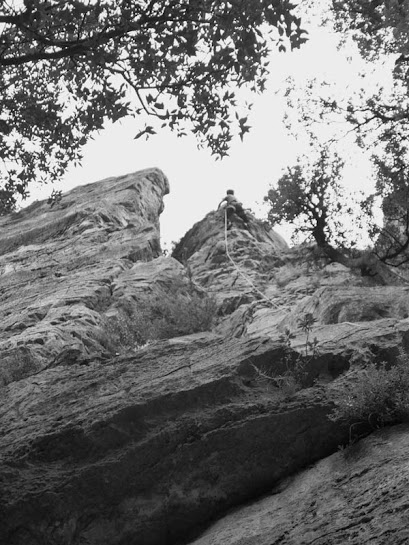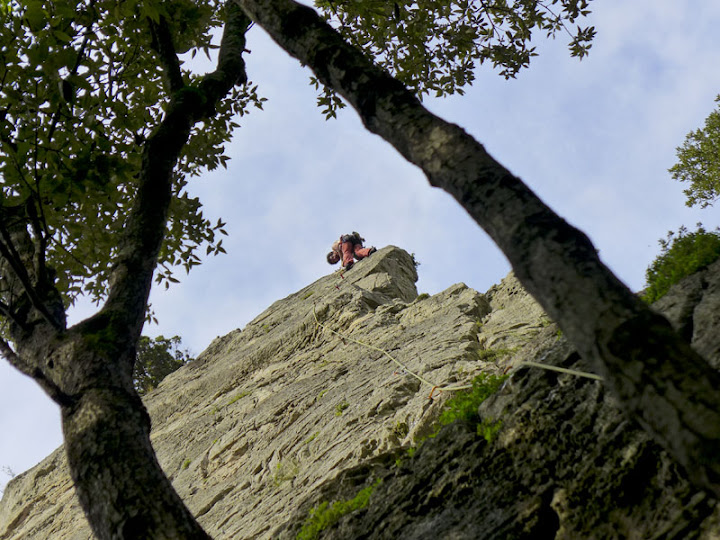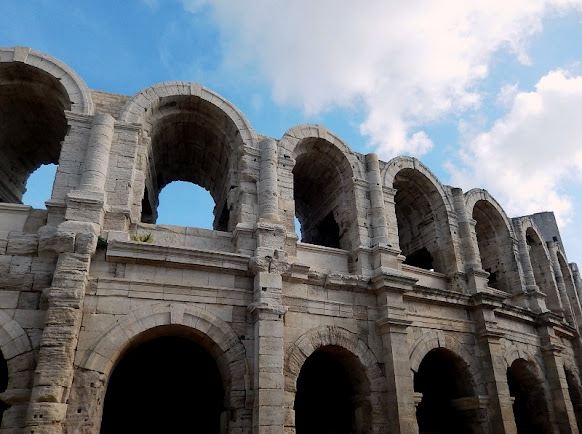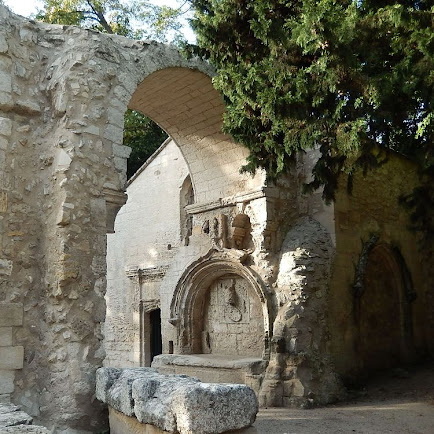Thursday, October 23rd 2014. A week left to complete our nomadic round-the-clock: twelve months on the road in our van TRANSITion!, living, working, volunteering, exploring and climbing. In a word, un(t)raveling... As we drove around Millau heading north-east to the gorgeous gorges de la Jonte, the mid-morning sun gave us a warm welcome. Medieval castles in ruins and gothic cathedrals of multicolour limestone emerging from the round green slopes, silver waters making their way through the bushes of oaks, wineyards, orchards and picturesque tiny villages. After last year's visit, it was indeed very nice to see the beautiful landscape around us with no rain, no mist, no fog. And quite exciting to discover a huge and almost too-good-to-be-true natural playground along the banks of le Tarn, la Jonte and - just a bit further, la Dourbie. "This time - Futuna said to himself as Wallis negociated a sharp curve before passing along the Bleu des Causses cheese coop - nothing will stop us from climbing!" Poor little thing, for thou did not know how true thy promise would prove to be...
 |
| the Gorgeous of the Jonte from the car park (and from left to right): Capluc, le Révérend, Pégase, la Cathédrale, le Cirque des Vases, la Roche décollée and le Bitard. |
Anyway, the twenty-five kilometer drive along la D907 finally took us through le R., a lovely village even tinier than the previous ones we had crossed, but world famous as the main entry and base camp to the gorges and their many climbing sectors. Behind the cross and ruins of le Capluc, stood in a quiet and wavy line of magnificent carved rocks the impassive shapes of Le révérend, Pégase, the Cathédrale, the Vases de Sèvre et de Chine, the Roche décollée, Le Bitard, La Licorne and Fusée. If many sport routes of all grades can be found along the gorges, these are particularly renowned for their multipitch climbing, tipically of 3-4 and up to 7-8 pitches, both bolted and trad. Despite the diferences in grade and style, most local climbs have in common their tough and old-school grading and equipment. Understand: when la Jonte's surprisingly expensive, vague and misleading climbing guidebook describes a V+ fully bolted route, you have to be prepared for anything ranging from a V+ fully bolted route to an exposed strenuous tricky 6a+ with 5 spits in about 30 meters (true story!). But any local would tell you this is the unique, second-to-none charm of la Jonte: its old school touch and thrilling big time adventure flavor... This statement is even the very introduction of the guidebook, poorly translated in no less than five languages. Printed in a drooling festival of black-and-orange Halloween-like confusing jumble of text and drawings, the authors explain "this second edition paid for 6 years of equipment and maintenance of the climbing sectors". No kidding! With a spit every 5+ meters, I bet the 25 euros of one sold guidebook are enough to equip a whole sector... Anyway, we'll have many opportunities to complain about this tough guys' philosophy during the next few days. As a french climber and blogger says (link below): "A la Jonte, il faut savoir deux choses : premièrement, on n'y va pas pour poser des dégaines mais pour grimper (dicton d'un grimpeur anonyme). Ensuite, "équipé loin" se dit "équipé athlétique". Quand on sait tout cela, on est armé!". But let's make a fresh start and enter the thick of it: a whole week of climbing un-birthday celebration under the sun!
 |
| from the second belay of Les femmes et les grimpeurs... |
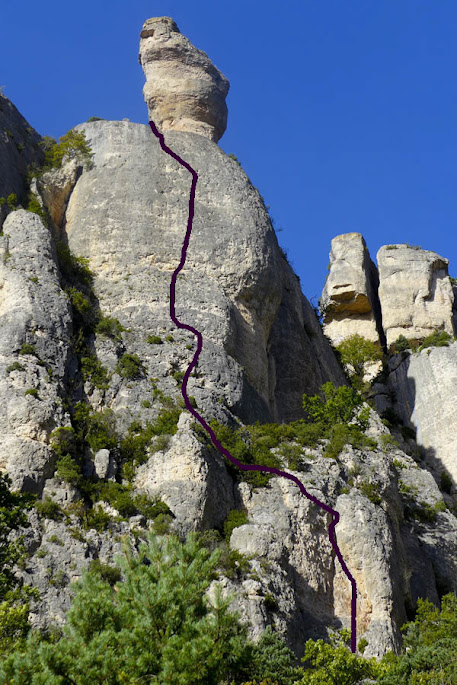 |
 |
 |
| the line of Les femmes et les grimpeurs ; a happy family at the second belay ; the mom in the last pitch (V+/6a). | ||
Day two: just a little bit! following the advice of an unknown but friendly and talkative would-be-local from Montpellier, we headed to the left side of le Bitard sector to try one of his must do's: the long traverse of La diagonale du gogol (140m - 6a+) that passes all the way behind the Roche décollée, to end up far left in the Cirque des Vases, pretty close to the Vase de Chine. The first two V pitches climb straight up an easy wall, where falling is not a concern but not an option either, because of the air between the bolts... The third one (V+) is a steady traverse passing in the shade of the Roche décollée, expertly lead climbed by Wallis who complained a little bit about the greediness of the avarice of the equipment. The fourth pitch and main course is a short but very steep little 6a+ wall with a couple of awkward moves to get off an overhanging slippery crack. Powerful and not too easy to read, it took Futuna two attempts to get rid of the crux and make it to the belay. Fifth pitch is another V+ traverse with fewer bolts than you'd dream of (and expect) that takes you to a breathtaking balcony with a view. And last but not least, the most enjoyable pitch crosses the slick face of a dihedral before climbing all the way up its twenty meter central overhanging crack, powerful and pleasant. Once she got to the top, Wallis declared something like "I understand the name of the route, now. The diagonale is quite obvious, but you do need to be a gogol (a retard) to wanna climb or recommend that!". Ha ha ha. Back down to earth, we took the van to the Belvédère des vautours car park and needed nothing but a warm-ish "solar" shower and a plentiful pasta with cheese and red wine to call it day and go to bed early! While climbing and particularly when Wallis leads or when Futuna is suffering, we do not always take the camera off the backpack. Here is a link to a very nice climbing blog (in fwench) with nice pictures of this route and some more we also climbed here and there... I guess we should ask them how they deal with shooting and chasing pics while they lead climb, because I often refuse to take the risk to break our dear little Lumix as I did with the former (and way less sexy) Cybershot.
 |
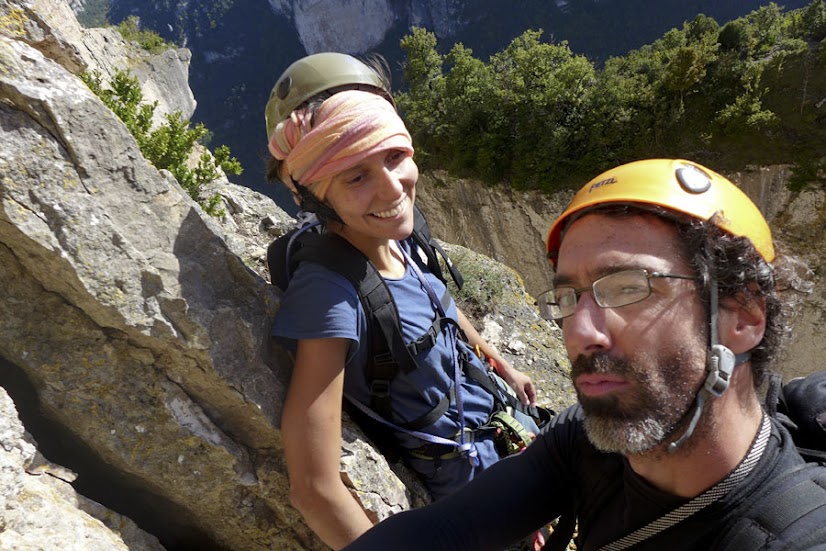 |
| enjoying a short rest in the sun and stretching the finger toes at the fifth belay... | |
 |
 |
| the amazing views from the last pitches of the route: the Roche décollée (left) and the Vase de Sèvre (right). | |
Day four: just a little bight. after a 24 hour break of uncertain weather, social networking, remote tele-conferencing and climbing gear hunting down in Millau, we took no risks on the cloudy morning of this fourth day and headed to the easy and enjoyable Le Révérend (110m - V+). Classic among the classics, the route does not have a single tricky move or crux, although some sections (especially the traverse in the second pitch, a decent V) are bolted with a bit of distance. This can be a bit of a problem for climbers who try their first multipitch and are used to sport bolting. Generally, most routes at la Jonte require you to be comfortable in the grade you climb: we successfully tried up to 6b - a fall or mistake can be pretty scary - but had to give up the nasty 6c pitch of the route just right of Le bitard (if you post us the name of the route, we'll send you a postcard from somewhere as a reward!) because the next bolt proved impossible to reach (for us). Anyway, back to the topic... Last pitch is a beautiful, nice and very fun thick crack taking you to the top of a needle just a few meters below the summit of le Révérend. What a nice and aerial, high mountain atmosphere for such a short and easy climb! It started to rain just as we prepared the rope for abseiling down, so we decided to safely hike along the Jacques Brunet trail towards Capluc, then back down to the start of the route and to the car park (about an hour in total). Shower, lunch/dinner and the begining of our F.F.Coppola cycle with "The godfather I", in bed with double blanket and a cup of tea! Al made us an offer we couldn't refuse...
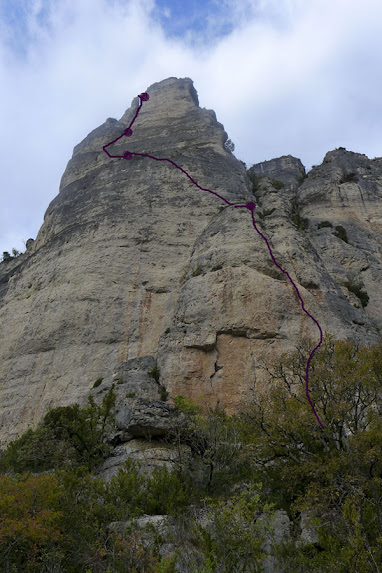 |
 |
 |
| the line of Le Révérend from the GR trail ; Wallis reaching the third belay ; the view of beautiful La cathédrale. | ||
Day five: just a little B (plan)? We were determined to climb Biotone and Crise éléphatine at the Cirque des vases. When we got at the foot of the first one, two rope parties were already stepping each other's fingers in both of them. We thought of La gueule du look as a good alternative, walked there only to find a rope party about to start. Plan B aborted. We followed the gorge, talked with the providential moustache-bearing-former-neighbour-of-Futuna's-sister-who-happened-to-be-climbing-there-on-that-day and he recomended we tried another easy classic among the easy classics: Le bitard (100m, V+), combined with À nous la légion, a tough two-pitches (an impressive V+ traverse and a hard 6a diagnoal crack), with the cherry on top: a overhanging abseiling down from the top of the route back to the summit of Le Bitard. We got there as a young couple started the route and waited for about 45 minutes: too tired to walk and too lazy to look for a plan D. The first four pitches (Le Bitard) are easy and, yes, really easy. Nice pockets and holds all along, a surprisingly varied rock - particularly beautiful in the second pitch - a slightly more physical, continuous section along the third pitch and an impressive patio with stunning views and vultures on the rock* to get to the top. The combo with À nous la légion is worth it, but not too much. Jumping from the top of le Bitard pilar to the main wall, with nothing but the rope on your shoulder and the belayer sitting behind you is but an aperitive for the poorly bolted 25 meter traverse along a thin ridge: first to be used with your feet, then (once all hand holds have suddenly disappeared) lowering as you can to hang to it with your hands and traversing with your feet in the void... But this is tipically worse for the second, so I won't complain. The 6a pitch is, sorry to say, hard for the grade: working your way along a diagonal crack on a very steep and eventually overhanging wall, hands and eels desperately searching the round lip for a hold. And as you'll guess, not too many bolts... Once you reach the top, your reward is a 20+ meter overhang to abseil down, what the Fwench call a fil d'araignée ("spider wire"), hanging from the ropes with no body part touching the wall, with no other option than spinning around weirdly until you eventually land on the small flat terrace of le Bitard. The friction hitch gets very hot as you fail to decide whether it's better to hurry up or to slow down... You should have seen Futuna's face!
 |
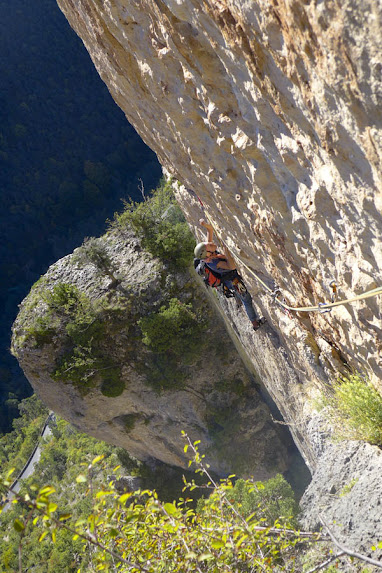 |
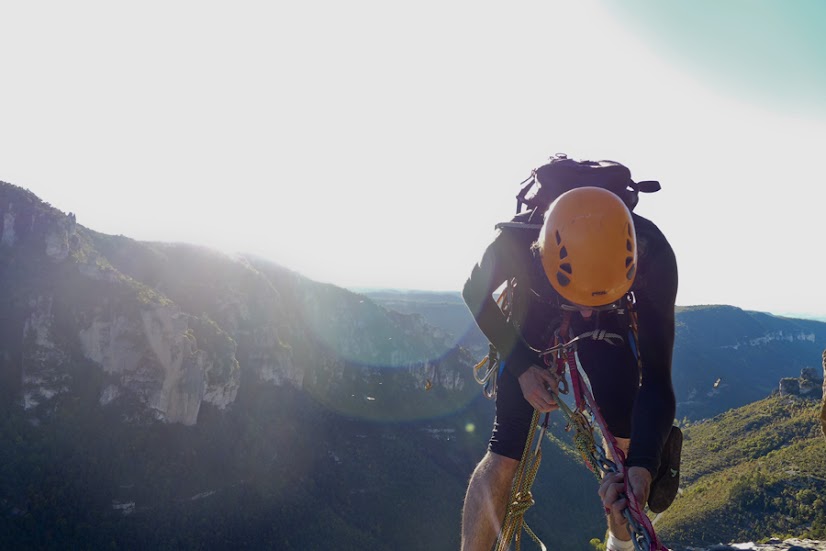 |
| classic Le bitard: nice and easy second pitch, impressive traverse of the fifth pitch and about to abseil down from the top. | ||
Day six: after talking with several climbers and observing a couple of rope parties struggling with the route, we decided NOT to climb the mythical Arête ouest of la Roche décollée and chose, instead, the straight line of La gueule du look (120m - 6a), a long scar that goes all the way up the south face of la Roche. We had heard the first pitch was long and the crappy local guidebook mistakingly showed the first belay anchor much lower than it actually was. We had heard a fifty meter rope was slightly too short and thought a sixty meter one would do the trick. After a nice promenade up an alpine-style crack, Futuna got stuck with just a few meters of rope left and no clue about where to expect the belay anchors. He felt lucky already that the line was extremely clear (follow the crack, follow the crack, follow the crack), because each next bolt could in no way be seen with bare eyes!
So, after an improvised belay was set a about 55 meters from the ground (a long sling around a boulder, a bolt and a comfrotable ridge for the feet), Wallis got up a good ten-to-twelve meters to an old, rusty anchor you would never use, unless explicitely told to (in a route description on a guidebook, for example). From there, she belayed Futuna up the last few meters of this exhausting 60 meter first pitch of a fairly easy 6a! The rest of the route was of the exact same "follow the crack" style, with distant bolts and an invisible second belay, hidden deep inside the crack... Even with this one, we completed the route in three pitches and still wonder what the actual sequence should be. Anyway... The last pitch was a lot of fun, especially when the crack opened wider and deeper, requiring you to sneak inside then choose your side. These last ten or fifteen meters had plenty of most welcome amazing holds and pockets, where one put their hands with great joy and relief, only to discover they were litterally full of vulture poop. Yummy! Once you reached the top, the way down was easy from the north side of la Roche: a short section abseiling down from an old oak, a steep trail and another comfortable section abseiling down to the ground, very close to the start of l'Arête. Hungry and tired, we decided to make the most of the day and headed straight to Biotone (90m, 6a+), which we climbed with haching feet and extreme thirst. Futuna managed to miss a belay again, resulting in another 50+ meter pitch that left him devastated. Wallis leadclimbed the last pitch and had the honour to settle at the surprisingly uncomfortable last belay, while no pictures were taken during the whole ascent... Long story made short: 200+ meters in 8 pitches of a generous 6a under a bright sun, a lot of complications and confusions with almost no water, but two beautiful and highly recomendable routes, indeed!
 |
| a party up La gueule du look, at Roche décollée. |
 |
 |
 |
| la gueule du look: the line, the way up to the "first" belay, the "second" belay inside the crack. | ||
 |
| the last meters of the last pitch: watcha where where the vultures poop and don't you... |
Day seven: determined to play a vibrant finish to this climbing symphony in spite of our state of fatigue, we woke up late and headed to the deepest part of les gorges, after a couple of young enthusiasts told us about Gallo loco. But we needed more, or so we thought! We ended up climbing L'air du temps (140m, 6b) instead. After a surprisingly hard first V+ pitch (did we miss something there?)combined with the second one (a nice V) to try and save some time, the third one was a beautiful 6a crack. Quite physical but really enjoyable, it only served to prepare us for the big piece of meat: a thin and technical 6b whose crux came right between the last bolt and the belay, By the way, why the hell were they so distant? A nasty and very long lateral move, with virtually no feet at all and nothing but a slippery roundish piece of crap for the right hand took Futuna a couple of attempts and a good fall before clipping the anchor. Fifth pitch was a short chimney followed by a short traverse to a cozy terrace. The last and sixth one would have been the average nice and easy 6a, if only Futuna hadn't mistakingly climbed the first half of the neighbour overhanging 7a+, resting at each and every bolt and thinking something like "Ford! I reckon I'm tired but this 6a is probably the hardest I've climbed so far". Ha ha ha... Let's be honest and recognize that the marvelous local guidebook clearly says you "have to be careful there and head to the left in order to follow the route"... We reached the top, drained and happy, walked along the cliff until the comfortable anchors and abseiled down with the sunset, enjoying the daylight until the very last minute, had a delicious last warm-ish "solar" shower and plentiful pasta with cheese and red wine, and happily called it a week!
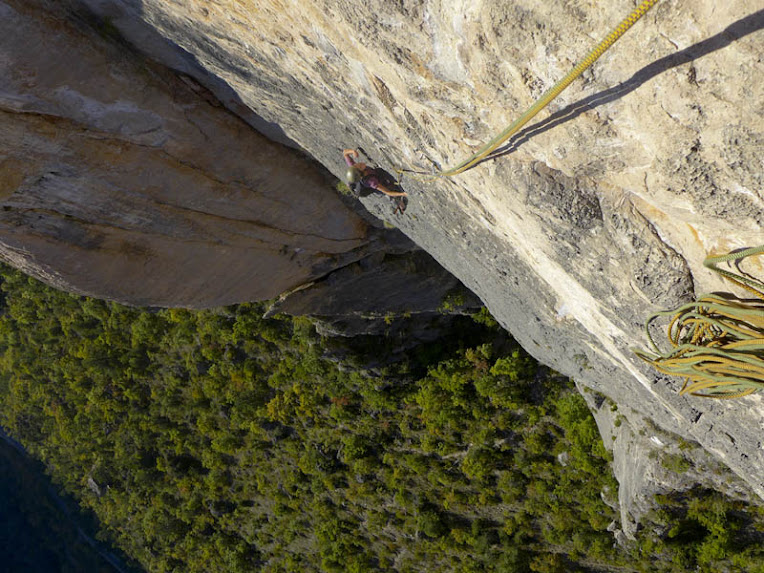 |
 |
 |
| l'air du temps: the (hard) fourth pitch, the last meters of the last pitch of the last climb and the way down. | ||
Epilogue: the story behind the story. On the morning of the second day, Futuna woke up with a sore shoulder but decided to say nothing and keep climbing. "It doesn't hurt while I climb, he said to himself, so if I keep climbing, it's gonna be alright". Poor simple-minded ingenuous little thing... As our readers can imagine, it only got worse as Futuna stuck to his promise to climb, climb and climb as long as the sun would keep shining. Almost one month and 3 osteopathy consultations, he still has his left arm tied to his chest, does nothing but social networking, blogging and online press reading, and accepts the opioid pills his mother offers him every other night to get some sleep... But hey, after a rainy year of unclimbing frustration, what would YOU have done in his place?
* Because they've been with us and around us all the time during these seven days on the rocks,
we want to give our warmest thanks to the feathery team of the vautours fauve (Gyps fulvus) of
the Gorgeous of the Jonte. Your support and presence were most appreciated, fellahs!
the Gorgeous of the Jonte. Your support and presence were most appreciated, fellahs!
Here are a few pictures of them, from us to you:
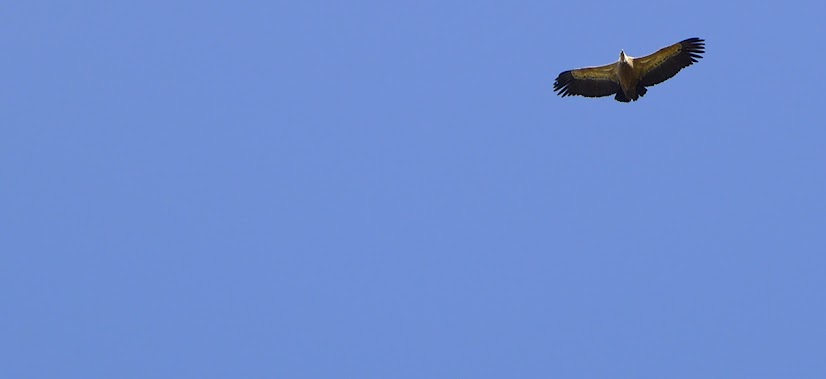 |
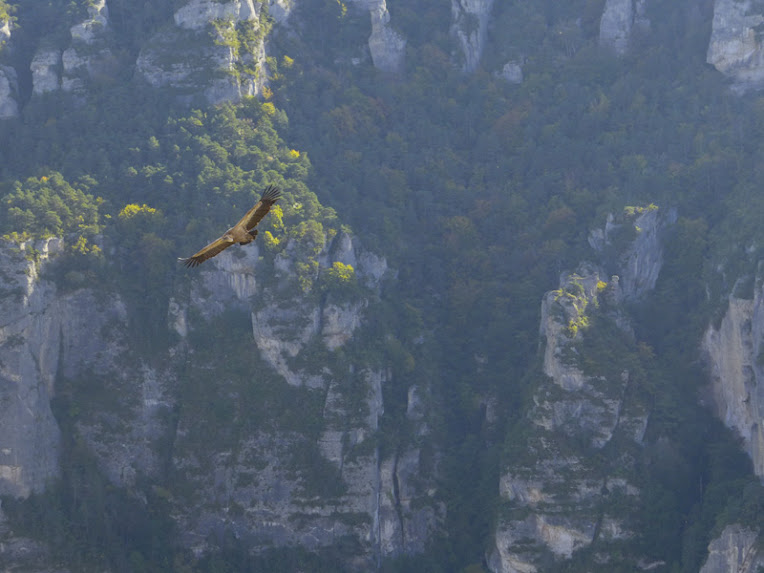 |
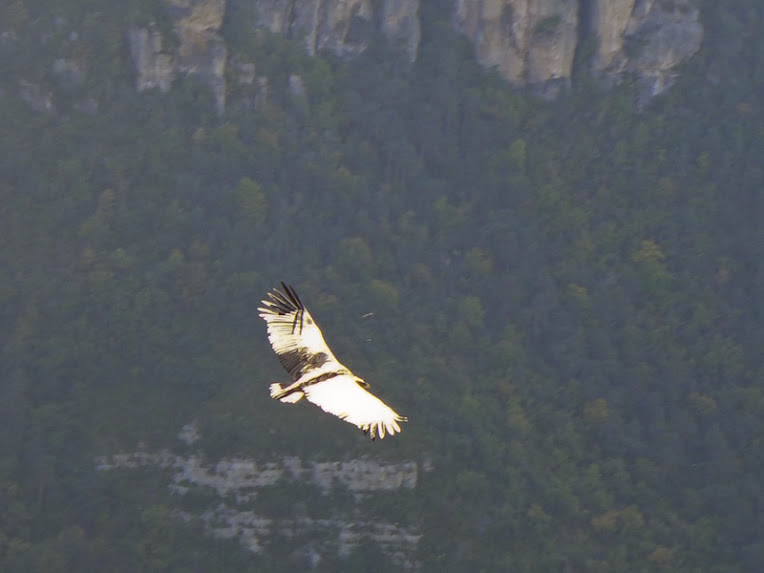 |
 |
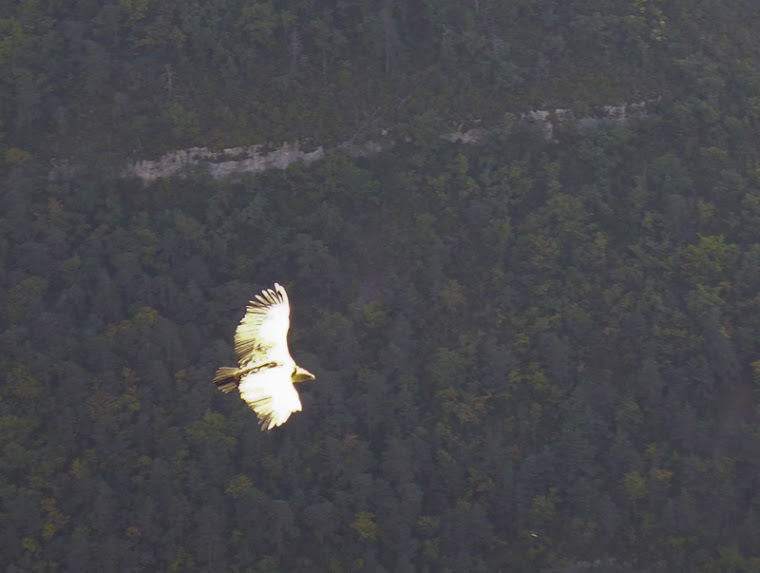 |
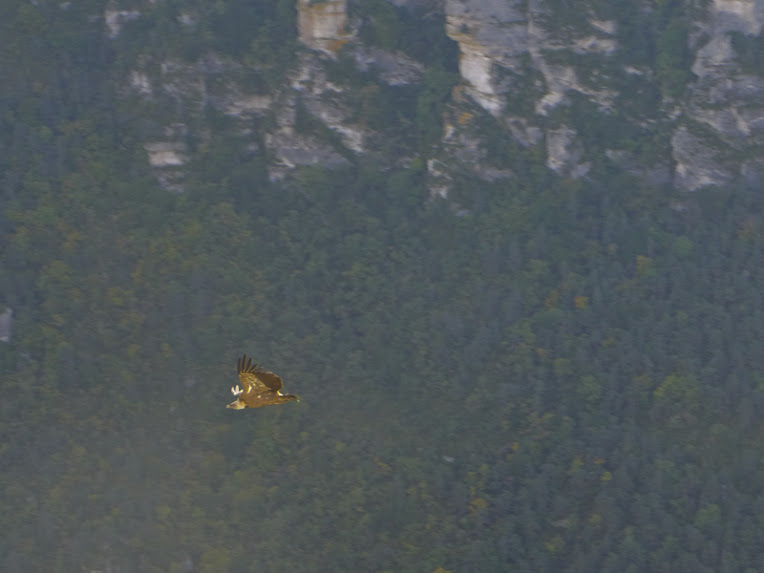 |
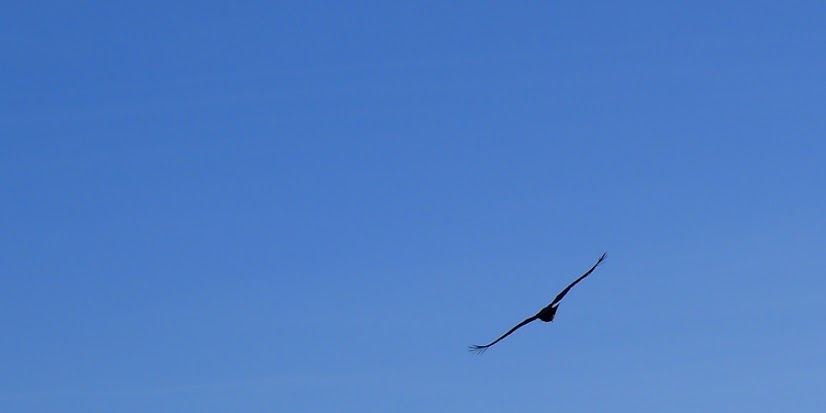 |






